
Aberdeen Bestiary
Encyclopedia
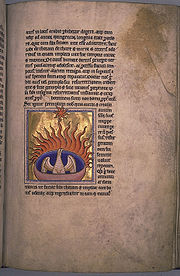
Illuminated manuscript
An illuminated manuscript is a manuscript in which the text is supplemented by the addition of decoration, such as decorated initials, borders and miniature illustrations...
bestiary
Bestiary
A bestiary, or Bestiarum vocabulum is a compendium of beasts. Bestiaries were made popular in the Middle Ages in illustrated volumes that described various animals, birds and even rocks. The natural history and illustration of each beast was usually accompanied by a moral lesson...
that was first listed in 1542 in the inventory of the Old Royal Library at the Palace of Westminster
Palace of Westminster
The Palace of Westminster, also known as the Houses of Parliament or Westminster Palace, is the meeting place of the two houses of the Parliament of the United Kingdom—the House of Lords and the House of Commons...
.
Information about its origins and patron are circumstantial. It probably comes from the 12th century and was owned by an ecclesiastical patron of the north or south province. The Aberdeen Bestiary is related to other bestiaries
Bestiary
A bestiary, or Bestiarum vocabulum is a compendium of beasts. Bestiaries were made popular in the Middle Ages in illustrated volumes that described various animals, birds and even rocks. The natural history and illustration of each beast was usually accompanied by a moral lesson...
of the Middle Ages
Middle Ages
The Middle Ages is a periodization of European history from the 5th century to the 15th century. The Middle Ages follows the fall of the Western Roman Empire in 476 and precedes the Early Modern Era. It is the middle period of a three-period division of Western history: Classic, Medieval and Modern...
and especially the Ashmole Bestiary
Ashmole Bestiary
The Ashmole Bestiary is a late 12th or early 13th century English illuminated manuscript Bestiary containing a creation story and detailed allegorical descriptions of over 100 animals...
. Some argue that the Aberdeen Bestiary might be the older of the two.
Creation
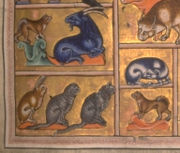

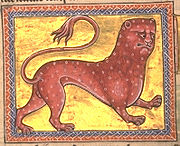

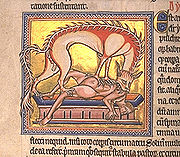
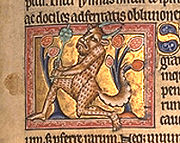

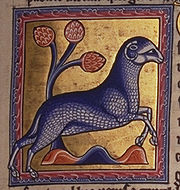
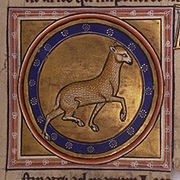
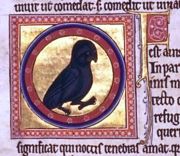

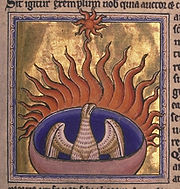
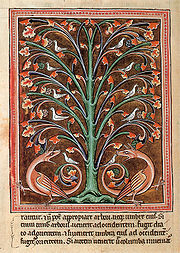
- Folio 1 (i.e., leaf) recto: Creation of heavenHeavenHeaven, the Heavens or Seven Heavens, is a common religious cosmological or metaphysical term for the physical or transcendent place from which heavenly beings originate, are enthroned or inhabit...
and earthEarthEarth is the third planet from the Sun, and the densest and fifth-largest of the eight planets in the Solar System. It is also the largest of the Solar System's four terrestrial planets...
(Genesis, 1: 1-5). - Folio 1 verso: Creation of the waterWaterWater is a chemical substance with the chemical formula H2O. A water molecule contains one oxygen and two hydrogen atoms connected by covalent bonds. Water is a liquid at ambient conditions, but it often co-exists on Earth with its solid state, ice, and gaseous state . Water also exists in a...
s and the firmamentFirmamentThe firmament is the vault or expanse of the sky. According to Genesis, God created the firmament to separate the oceans from other waters above.-Etymology:...
(Genesis, 1: 6-8). - Folio 2 recto : Creation of the birdBirdBirds are feathered, winged, bipedal, endothermic , egg-laying, vertebrate animals. Around 10,000 living species and 188 families makes them the most speciose class of tetrapod vertebrates. They inhabit ecosystems across the globe, from the Arctic to the Antarctic. Extant birds range in size from...
s and fishFishFish are a paraphyletic group of organisms that consist of all gill-bearing aquatic vertebrate animals that lack limbs with digits. Included in this definition are the living hagfish, lampreys, and cartilaginous and bony fish, as well as various extinct related groups...
es (Genesis, 1: 20-23). - Folio 2 verso : Creation of the animalAnimalAnimals are a major group of multicellular, eukaryotic organisms of the kingdom Animalia or Metazoa. Their body plan eventually becomes fixed as they develop, although some undergo a process of metamorphosis later on in their life. Most animals are motile, meaning they can move spontaneously and...
s (Genesis, 1: 24-25). - Folio 3 recto : Creation of manManThe term man is used for an adult human male . However, man is sometimes used to refer to humanity as a whole...
(Genesis, 1: 26-28, 31; 2: 1-2). - Folio 5 recto : Adam names the animalAnimalAnimals are a major group of multicellular, eukaryotic organisms of the kingdom Animalia or Metazoa. Their body plan eventually becomes fixed as they develop, although some undergo a process of metamorphosis later on in their life. Most animals are motile, meaning they can move spontaneously and...
s (Isidore of SevilleIsidore of SevilleSaint Isidore of Seville served as Archbishop of Seville for more than three decades and is considered, as the historian Montalembert put it in an oft-quoted phrase, "le dernier savant du monde ancien"...
, EtymologiaeEtymologiaeEtymologiae is an encyclopedia compiled by Isidore of Seville towards the end of his life. It forms a bridge between a condensed epitome of classical learning at the close of Late Antiquity and the inheritance received, in large part through Isidore's work, by the early Middle Ages...
, Book XII, i, 1-2). - Folio 5 verso : AnimalAnimalAnimals are a major group of multicellular, eukaryotic organisms of the kingdom Animalia or Metazoa. Their body plan eventually becomes fixed as they develop, although some undergo a process of metamorphosis later on in their life. Most animals are motile, meaning they can move spontaneously and...
(Animal) (Isidore of Seville, Etymologiae, Book XII, i, 3) - Folio 5 verso : QuadrupedQuadrupedQuadrupedalism is a form of land animal locomotion using four limbs or legs. An animal or machine that usually moves in a quadrupedal manner is known as a quadruped, meaning "four feet"...
(Quadrupes) (Isidore of Seville, Etymologiae, Book XII, i, 4) - Folio 5 verso : LivestockLivestockLivestock refers to one or more domesticated animals raised in an agricultural setting to produce commodities such as food, fiber and labor. The term "livestock" as used in this article does not include poultry or farmed fish; however the inclusion of these, especially poultry, within the meaning...
(Pecus) (Isidore of Seville, Etymologiae, Book XII, i, 5-6) - Folio 5 verso : Beast of burdenPack animalA pack animal or beast of burden is a working animal used by humans as means of transporting materials by attaching them so their weight bears on the animal's back; the term may be applied to either an individual animal or a species so employed...
(Iumentum) (Isidore of Seville, Etymologiae, Book XII, i, 7) - Folio 5 verso : HerdHerdHerd refers to a social grouping of certain animals of the same species, either wild or domestic, and also to the form of collective animal behavior associated with this or as a verb, to herd, to its control by another species such as humans or dogs.The term herd is generally applied to mammals,...
(Armentum) (Isidore of Seville, Etymologiae, Book XII, i, 8)
Beasts (Bestiae)
- Folio 7 recto : LionLionThe lion is one of the four big cats in the genus Panthera, and a member of the family Felidae. With some males exceeding 250 kg in weight, it is the second-largest living cat after the tiger...
(Leo) (Physiologus, Chapter 1; Isidore of SevilleIsidore of SevilleSaint Isidore of Seville served as Archbishop of Seville for more than three decades and is considered, as the historian Montalembert put it in an oft-quoted phrase, "le dernier savant du monde ancien"...
, EtymologiaeEtymologiaeEtymologiae is an encyclopedia compiled by Isidore of Seville towards the end of his life. It forms a bridge between a condensed epitome of classical learning at the close of Late Antiquity and the inheritance received, in large part through Isidore's work, by the early Middle Ages...
, Book XII, ii, 3-6) - Folio 8 recto : TigerTigerThe tiger is the largest cat species, reaching a total body length of up to and weighing up to . Their most recognizable feature is a pattern of dark vertical stripes on reddish-orange fur with lighter underparts...
(Tigris) (Isidore of Seville, Etymologiae, Book XII, ii, 7) - Folio 8 verso : PardPard (legendary creature)Pard is an animal from Medieval bestiaries. They were felines with spotted coats, and were extremely fast . They were believed to mate with lions to produce leopards....
(Pard) (Isidore of Seville, Etymologiae, Book XII, ii, 10-11) - Folio 9 recto : PantherPanther (legendary creature)A Panther is a creature out of ancient myth that resembles a big cat with a multicoloured hide.Under medieval belief after feasting the panther will sleep in a cave for a total of three days. After this period ends, the panther roars, in the process emitting a sweet smelling odor...
(Panther) (Physiologus, Chapter 16; Isidore of Seville, Etymologiae, Book XII, ii, 8-9)
After folio 9 verso some leaves are missing which should have contained Antelope
Antelope
Antelope is a term referring to many even-toed ungulate species indigenous to various regions in Africa and Eurasia. Antelopes comprise a miscellaneous group within the family Bovidae, encompassing those old-world species that are neither cattle, sheep, buffalo, bison, nor goats...
(Antalops), Unicorn
Unicorn
The unicorn is a legendary animal from European folklore that resembles a white horse with a large, pointed, spiraling horn projecting from its forehead, and sometimes a goat's beard...
(Unicornis), Lynx
Lynx
A lynx is any of the four Lynx genus species of medium-sized wildcats. The name "lynx" originated in Middle English via Latin from Greek word "λύγξ", derived from the Indo-European root "*leuk-", meaning "light, brightness", in reference to the luminescence of its reflective eyes...
(Lynx), Griffin
Griffin
The griffin, griffon, or gryphon is a legendary creature with the body of a lion and the head and wings of an eagle...
(Gryps) and part of Elephant
Elephant
Elephants are large land mammals in two extant genera of the family Elephantidae: Elephas and Loxodonta, with the third genus Mammuthus extinct...
(Elephans).
- Folio 10 recto : ElephantElephantElephants are large land mammals in two extant genera of the family Elephantidae: Elephas and Loxodonta, with the third genus Mammuthus extinct...
(Elephans) (Isidore of Seville, Etymologiae, Book XII, ii, 14; Physiologus, Chapter 43; AmbroseAmbroseAurelius Ambrosius, better known in English as Saint Ambrose , was a bishop of Milan who became one of the most influential ecclesiastical figures of the 4th century. He was one of the four original doctors of the Church.-Political career:Ambrose was born into a Roman Christian family between about...
, Hexaemeron, Book VI, 35; SolinusGaius Julius SolinusGaius Julius Solinus, Latin grammarian and compiler, probably flourished in the early third century. Historical scholar Theodor Mommsen dates him to the middle of the third century....
, Collectanea rerum memorabilium, xxv, 1-7) - Folio 11 recto : BeaverBeaverThe beaver is a primarily nocturnal, large, semi-aquatic rodent. Castor includes two extant species, North American Beaver and Eurasian Beaver . Beavers are known for building dams, canals, and lodges . They are the second-largest rodent in the world...
(Castor) - Folio 11 recto : Ibex (Ibex) (Hugh of FouilloyHugh of FouilloyHugh of Fouilloy, born between 1096 and 1111 in Fouilloy and died ca. 1172, was a French cleric, prior of St.-Nicholas-de-Regny and St.-Laurent-au-Bois . He is notable for writing De claustro animae and De medicina animae , allegorical texts on monastic spirituality...
, II, 15) - Folio 11 verso : HyenaHyenaHyenas or Hyaenas are the animals of the family Hyaenidae of suborder feliforms of the Carnivora. It is the fourth smallest biological family in the Carnivora , and one of the smallest in the mammalia...
(Yena) (Physiologus, Chapter 24; Solinus, Collectanea rerum memorabilium, xxvii, 23-24)- Folio 12 recto : CrocottaCrocottaThe crocotta , is a mythical dog-wolf of India or Ethiopia, linked to the hyena and said to be a deadly enemy of men and dogs.-Ancient Accounts:...
(Crocotta) (Solinus, Collectanea rerum memorabilium, xxvii, 26)
- Folio 12 recto : Crocotta
- Folio 12 recto : BonnaconBonnaconThe Bonnacon is a mythical animal from Asia. It has curled horns and emits burning dung. The legend may be based on a type of bison in reality...
(Bonnacon) (Solinus, Collectanea rerum memorabilium, xl, 10-11) - Folio 12 verso : ApeApeApes are Old World anthropoid mammals, more specifically a clade of tailless catarrhine primates, belonging to the biological superfamily Hominoidea. The apes are native to Africa and South-east Asia, although in relatively recent times humans have spread all over the world...
(Simia) - Folio 13 recto : SatyrSatyrIn Greek mythology, satyrs are a troop of male companions of Pan and Dionysus — "satyresses" were a late invention of poets — that roamed the woods and mountains. In myths they are often associated with pipe-playing....
(Satyrs) - Folio 13 recto : DeerDeerDeer are the ruminant mammals forming the family Cervidae. Species in the Cervidae family include white-tailed deer, elk, moose, red deer, reindeer, fallow deer, roe deer and chital. Male deer of all species and female reindeer grow and shed new antlers each year...
(Cervus) - Folio 14 recto : GoatGoatThe domestic goat is a subspecies of goat domesticated from the wild goat of southwest Asia and Eastern Europe. The goat is a member of the Bovidae family and is closely related to the sheep as both are in the goat-antelope subfamily Caprinae. There are over three hundred distinct breeds of...
(Caper) - Folio 14 verso : Wild goatWild GoatThe wild goat is a widespread species of goat, with a distribution ranging from Europe and Asia Minor to central Asia and the Middle East. It is the ancestor of the domestic goat.-Social structure:...
(Caprea) - Folio 15 recto : MonocerosMonocerusThe monocerus is a legendary animal with only one horn. It derives from the Greek word Μονόκερος, a compound word from μόνος which means one and κέρας which means horn. Although the name has been applied to a variety of genuine and mythological animals, it is usually applied to the unicorn or...
(Monoceros) (SolinusGaius Julius SolinusGaius Julius Solinus, Latin grammarian and compiler, probably flourished in the early third century. Historical scholar Theodor Mommsen dates him to the middle of the third century....
, Collectanea rerum memorabilium, lii, 39-40) - Folio 15 recto : BearBearBears are mammals of the family Ursidae. Bears are classified as caniforms, or doglike carnivorans, with the pinnipeds being their closest living relatives. Although there are only eight living species of bear, they are widespread, appearing in a wide variety of habitats throughout the Northern...
(Ursus) - Folio 15 verso : LeucrotaCrocottaThe crocotta , is a mythical dog-wolf of India or Ethiopia, linked to the hyena and said to be a deadly enemy of men and dogs.-Ancient Accounts:...
(Leucrota) (Solinus, Collectanea rerum memorabilium, lii, 34)
After folio 15 verso some leaves are missing which should have contained Crocodile
Crocodile
A crocodile is any species belonging to the family Crocodylidae . The term can also be used more loosely to include all extant members of the order Crocodilia: i.e...
(Crocodilus), Manticore
Manticore
The manticore is a legendary creature similar to the Egyptian sphinx. It has the body of a red lion, a human head with three rows of sharp teeth , and a trumpet-like voice. Other aspects of the creature vary from story to story. It may be horned, winged, or both...
(Mantichora) and part of Parandrus
Parandrus
Parandrus is an animal from Medieval bestiaries. They were ox-sized, long-haired, with antlers and cloven hooves, but could change their shape at will....
(Parandrus).
- Folio 16 recto : ParandrusParandrusParandrus is an animal from Medieval bestiaries. They were ox-sized, long-haired, with antlers and cloven hooves, but could change their shape at will....
(Parandrus) (Solinus, Collectanea rerum memorabilium, xxx, 25) - Folio 16 recto : FoxFoxFox is a common name for many species of omnivorous mammals belonging to the Canidae family. Foxes are small to medium-sized canids , characterized by possessing a long narrow snout, and a bushy tail .Members of about 37 species are referred to as foxes, of which only 12 species actually belong to...
(Vulpes) - Folio 16 verso : YaleYale (mythical creature)The yale is a mythical beast found in European mythology. Most descriptions make it an antelope- or goat-like four-legged creature with large horns that it can swivel in any direction....
(Eale) (Solinus, Collectanea rerum memorabilium, lii, 35) - Folio 16 verso : WolfGray WolfThe gray wolf , also known as the wolf, is the largest extant wild member of the Canidae family...
(Lupus) - Folio 18 recto : DogDogThe domestic dog is a domesticated form of the gray wolf, a member of the Canidae family of the order Carnivora. The term is used for both feral and pet varieties. The dog may have been the first animal to be domesticated, and has been the most widely kept working, hunting, and companion animal in...
(Canis)
Livestocks (Pecora)
- Folio 20 verso : SheepDomestic sheepSheep are quadrupedal, ruminant mammals typically kept as livestock. Like all ruminants, sheep are members of the order Artiodactyla, the even-toed ungulates. Although the name "sheep" applies to many species in the genus Ovis, in everyday usage it almost always refers to Ovis aries...
(Ovis) (Isidore of SevilleIsidore of SevilleSaint Isidore of Seville served as Archbishop of Seville for more than three decades and is considered, as the historian Montalembert put it in an oft-quoted phrase, "le dernier savant du monde ancien"...
, EtymologiaeEtymologiaeEtymologiae is an encyclopedia compiled by Isidore of Seville towards the end of his life. It forms a bridge between a condensed epitome of classical learning at the close of Late Antiquity and the inheritance received, in large part through Isidore's work, by the early Middle Ages...
, Book XII, i, 9; AmbroseAmbroseAurelius Ambrosius, better known in English as Saint Ambrose , was a bishop of Milan who became one of the most influential ecclesiastical figures of the 4th century. He was one of the four original doctors of the Church.-Political career:Ambrose was born into a Roman Christian family between about...
, HexaemeronCreation according to GenesisThe Genesis creation narrative describes the divine creation of the world including the first man and woman...
, Book VI, 20) - Folio 21 recto : WetherDomestic sheepSheep are quadrupedal, ruminant mammals typically kept as livestock. Like all ruminants, sheep are members of the order Artiodactyla, the even-toed ungulates. Although the name "sheep" applies to many species in the genus Ovis, in everyday usage it almost always refers to Ovis aries...
(Vervex) (Isidore of Seville, Etymologiae, Book XII, i, 10)- Folio 21 recto : RamDomestic sheepSheep are quadrupedal, ruminant mammals typically kept as livestock. Like all ruminants, sheep are members of the order Artiodactyla, the even-toed ungulates. Although the name "sheep" applies to many species in the genus Ovis, in everyday usage it almost always refers to Ovis aries...
(Aries) (Isidore of Seville, Etymologiae, Book XII, i, 11)
- Folio 21 recto : Ram
- Folio 21 recto : LambDomestic sheepSheep are quadrupedal, ruminant mammals typically kept as livestock. Like all ruminants, sheep are members of the order Artiodactyla, the even-toed ungulates. Although the name "sheep" applies to many species in the genus Ovis, in everyday usage it almost always refers to Ovis aries...
(Agnus) (Isidore of Seville, Etymologiae, Book XII, i, 12; Ambrose, Hexaemeron, Book VI, 28) - Folio 21 recto : He-goatGoatThe domestic goat is a subspecies of goat domesticated from the wild goat of southwest Asia and Eastern Europe. The goat is a member of the Bovidae family and is closely related to the sheep as both are in the goat-antelope subfamily Caprinae. There are over three hundred distinct breeds of...
(Hircus) (Isidore of Seville, Etymologiae, Book XII, i, 14)- Folio 21 verso : KidGoatThe domestic goat is a subspecies of goat domesticated from the wild goat of southwest Asia and Eastern Europe. The goat is a member of the Bovidae family and is closely related to the sheep as both are in the goat-antelope subfamily Caprinae. There are over three hundred distinct breeds of...
(Hedus) (Isidore of Seville, Etymologiae, Book XII, i, 13)
- Folio 21 verso : Kid
- Folio 21 verso : Boar (Aper) (Isidore of Seville, Etymologiae, Book XII, i, 27)
- Folio 21 verso : BullockCattleCattle are the most common type of large domesticated ungulates. They are a prominent modern member of the subfamily Bovinae, are the most widespread species of the genus Bos, and are most commonly classified collectively as Bos primigenius...
(Iuvencus) (Isidore of Seville, Etymologiae, Book XII, i, 28)- Folio 21 verso : BullBullBull usually refers to an uncastrated adult male bovine.Bull may also refer to:-Entertainment:* Bull , an original show on the TNT Network* "Bull" , an episode of television series CSI: Crime Scene Investigation...
(Taurus) (Isidore of Seville, Etymologiae, Book XII, i, 29)
- Folio 21 verso : Bull
After folio 21 verso two leaves are missing which should have contained Ox
Ox
An ox , also known as a bullock in Australia, New Zealand and India, is a bovine trained as a draft animal. Oxen are commonly castrated adult male cattle; castration makes the animals more tractable...
(Bos), Camel
Camel
A camel is an even-toed ungulate within the genus Camelus, bearing distinctive fatty deposits known as humps on its back. There are two species of camels: the dromedary or Arabian camel has a single hump, and the bactrian has two humps. Dromedaries are native to the dry desert areas of West Asia,...
(Camelus), Dromedary
Dromedary
The dromedary or Arabian camel is a large, even-toed ungulate with one hump on its back. Its native range is unclear, but it was probably the Arabian Peninsula. The domesticated form occurs widely in North Africa and the Middle East...
(Dromedarius), Ass
Donkey
The donkey or ass, Equus africanus asinus, is a domesticated member of the Equidae or horse family. The wild ancestor of the donkey is the African Wild Ass, E...
(Asinus), Onager
Onager
The Onager is a large member of the genus Equus of the family Equidae native to the deserts of Syria, Iran, Pakistan, India, Israel and Tibet...
(Onager) and part of Horse
Horse
The horse is one of two extant subspecies of Equus ferus, or the wild horse. It is a single-hooved mammal belonging to the taxonomic family Equidae. The horse has evolved over the past 45 to 55 million years from a small multi-toed creature into the large, single-toed animal of today...
(Equus).
- Folio 22 recto : HorseHorseThe horse is one of two extant subspecies of Equus ferus, or the wild horse. It is a single-hooved mammal belonging to the taxonomic family Equidae. The horse has evolved over the past 45 to 55 million years from a small multi-toed creature into the large, single-toed animal of today...
(Equus) (Isidore of Seville, Etymologiae, Book XII, i, 41-56; Hugh of FouilloyHugh of FouilloyHugh of Fouilloy, born between 1096 and 1111 in Fouilloy and died ca. 1172, was a French cleric, prior of St.-Nicholas-de-Regny and St.-Laurent-au-Bois . He is notable for writing De claustro animae and De medicina animae , allegorical texts on monastic spirituality...
, III, xxiii)- Folio 23 recto : MuleMuleA mule is the offspring of a male donkey and a female horse. Horses and donkeys are different species, with different numbers of chromosomes. Of the two F1 hybrids between these two species, a mule is easier to obtain than a hinny...
(Mulus) (Isidore of Seville, Etymologiae, Book XII, i, 57-60)
- Folio 23 recto : Mule
Small animals (Minuta animala)
- Folio 23 verso : CatCatThe cat , also known as the domestic cat or housecat to distinguish it from other felids and felines, is a small, usually furry, domesticated, carnivorous mammal that is valued by humans for its companionship and for its ability to hunt vermin and household pests...
(Musio) (Isidore of SevilleIsidore of SevilleSaint Isidore of Seville served as Archbishop of Seville for more than three decades and is considered, as the historian Montalembert put it in an oft-quoted phrase, "le dernier savant du monde ancien"...
, EtymologiaeEtymologiaeEtymologiae is an encyclopedia compiled by Isidore of Seville towards the end of his life. It forms a bridge between a condensed epitome of classical learning at the close of Late Antiquity and the inheritance received, in large part through Isidore's work, by the early Middle Ages...
, Book XII, ii, 38) - Folio 23 verso : MouseMouseA mouse is a small mammal belonging to the order of rodents. The best known mouse species is the common house mouse . It is also a popular pet. In some places, certain kinds of field mice are also common. This rodent is eaten by large birds such as hawks and eagles...
(Mus) (Isidore of Seville, Etymologiae, Book XII, iii, 1) - Folio 23 verso : WeaselWeaselWeasels are mammals forming the genus Mustela of the Mustelidae family. They are small, active predators, long and slender with short legs....
(Mustela) (Isidore of Seville, Etymologiae, Book XII, iii, 2; Physiologus, Chapter 21) - Folio 24 recto : MoleMole (animal)Moles are small cylindrical mammals adapted to a subterranean lifestyle. They have velvety fur; tiny or invisible ears and eyes; and short, powerful limbs with large paws oriented for digging. The term is especially and most properly used for the true moles, those of the Talpidae family in the...
(Talpa) (Isidore of Seville, Etymologiae, Book XII, iii, 5) - Folio 24 recto : HedgehogHedgehogA hedgehog is any of the spiny mammals of the subfamily Erinaceinae and the order Erinaceomorpha. There are 17 species of hedgehog in five genera, found through parts of Europe, Asia, Africa, and New Zealand . There are no hedgehogs native to Australia, and no living species native to the Americas...
(Ericius) (Isidore of Seville, Etymologiae, Book XII, iii, 7; AmbroseAmbroseAurelius Ambrosius, better known in English as Saint Ambrose , was a bishop of Milan who became one of the most influential ecclesiastical figures of the 4th century. He was one of the four original doctors of the Church.-Political career:Ambrose was born into a Roman Christian family between about...
, HexaemeronCreation according to GenesisThe Genesis creation narrative describes the divine creation of the world including the first man and woman...
, VI, 20) - Folio 24 verso : AntAntAnts are social insects of the family Formicidae and, along with the related wasps and bees, belong to the order Hymenoptera. Ants evolved from wasp-like ancestors in the mid-Cretaceous period between 110 and 130 million years ago and diversified after the rise of flowering plants. More than...
(Formica) (Physiologus, 12; Ambrose, Hexaemeron, Book VI, 16, 20)
Birds (Aves)
- Folio 25 recto : BirdBirdBirds are feathered, winged, bipedal, endothermic , egg-laying, vertebrate animals. Around 10,000 living species and 188 families makes them the most speciose class of tetrapod vertebrates. They inhabit ecosystems across the globe, from the Arctic to the Antarctic. Extant birds range in size from...
(Avis) - Folio 25 verso : Dove (Columba)
- Folio 26 recto : Dove and HawkHawkThe term hawk can be used in several ways:* In strict usage in Australia and Africa, to mean any of the species in the subfamily Accipitrinae, which comprises the genera Accipiter, Micronisus, Melierax, Urotriorchis and Megatriorchis. The large and widespread Accipiter genus includes goshawks,...
(Columba et Accipiter) - Folio 26 verso : Dove (Columba)
- Folio 29 verso : North windNorth windA north wind is a wind that originates in the north and blows south. The north wind has had historical and literal significance, since it often signals cold weather and seasonal change in the Northern hemisphere.-Mythology:...
and South windSouth windFor other uses, see South wind .A south wind is a wind that originates in the south and blows north.Words used in English to describe the south wind are auster, buster , föhn/foehn , gibli , friagem , khamsin For other uses, see South wind (disambiguation).A south wind is a wind that originates in...
(Aquilo et Auster ventus) - Folio 30 recto : HawkHawkThe term hawk can be used in several ways:* In strict usage in Australia and Africa, to mean any of the species in the subfamily Accipitrinae, which comprises the genera Accipiter, Micronisus, Melierax, Urotriorchis and Megatriorchis. The large and widespread Accipiter genus includes goshawks,...
(Accipiter) - Folio 31 recto : Turtle doveTurtle DoveThe European Turtle Dove , also known as Turtle Dove, is a member of the bird family Columbidae, which includes the doves and pigeons.-Distribution & Status:...
(Turtur) - Folio 32 verso : Palm treeArecaceaeArecaceae or Palmae , are a family of flowering plants, the only family in the monocot order Arecales. There are roughly 202 currently known genera with around 2600 species, most of which are restricted to tropical, subtropical, and warm temperate climates...
(Palma) - Folio 33 verso : Cedar (Cedrus)
- Folio 34 verso : PelicanPelicanA pelican, derived from the Greek word πελεκυς pelekys is a large water bird with a large throat pouch, belonging to the bird family Pelecanidae....
(Pellicanus) - Folio 35 verso : Night heronNight heronThe night herons are medium-sized herons in the genera Nycticorax, Nyctanassa and Gorsachius. The genus name Nycticorax derives from the Greek for “night raven” and refers to the largely nocturnal feeding habits of this group of birds, and the croaking crow-like call of the best known species, the...
(Nicticorax) - Folio 36 recto : HoopoeHoopoeThe Hoopoe is a colourful bird that is found across Afro-Eurasia, notable for its distinctive 'crown' of feathers. It is the only extant species in the family Upupidae. One insular species, the Giant Hoopoe of Saint Helena, is extinct, and the Madagascar subspecies of the Hoopoe is sometimes...
(Epops) - Folio 36 verso : MagpieMagpieMagpies are passerine birds of the crow family, Corvidae.In Europe, "magpie" is often used by English speakers as a synonym for the European Magpie, as there are no other magpies in Europe outside Iberia...
(Pica) - Folio 37 recto : RavenCommon RavenThe Common Raven , also known as the Northern Raven, is a large, all-black passerine bird. Found across the northern hemisphere, it is the most widely distributed of all corvids...
(Corvus) - Folio 38 verso : CockRoosterA rooster, also known as a cockerel, cock or chanticleer, is a male chicken with the female being called a hen. Immature male chickens of less than a year's age are called cockerels...
(Gallus) - Folio 41 recto : OstrichOstrichThe Ostrich is one or two species of large flightless birds native to Africa, the only living member of the genus Struthio. Some analyses indicate that the Somali Ostrich may be better considered a full species apart from the Common Ostrich, but most taxonomists consider it to be a...
(Strutio) - Folio 44 recto : VultureVultureVulture is the name given to two groups of convergently evolved scavenging birds, the New World Vultures including the well-known Californian and Andean Condors, and the Old World Vultures including the birds which are seen scavenging on carcasses of dead animals on African plains...
(Vultur) - Folio 45 verso : CraneCrane (bird)Cranes are a family, Gruidae, of large, long-legged and long-necked birds in the order Gruiformes. There are fifteen species of crane in four genera. Unlike the similar-looking but unrelated herons, cranes fly with necks outstretched, not pulled back...
(Grus) - Folio 46 verso : KiteKite (bird)Kites are raptors with long wings and weak legs which spend a great deal of time soaring. Most feed mainly on carrion but some take various amounts of live prey.They are birds of prey which, along with hawks and eagles, are from the family Accipitridae....
(Milvus) - Folio 46 verso : ParrotParrotParrots, also known as psittacines , are birds of the roughly 372 species in 86 genera that make up the order Psittaciformes, found in most tropical and subtropical regions. The order is subdivided into three families: the Psittacidae , the Cacatuidae and the Strigopidae...
(Psitacus) - Folio 47 recto : IbisIbisThe ibises are a group of long-legged wading birds in the family Threskiornithidae....
(Ibis) - Folio 47 verso : SwallowSwallowThe swallows and martins are a group of passerine birds in the family Hirundinidae which are characterised by their adaptation to aerial feeding...
(Yrundo) - Folio 48 verso : StorkStorkStorks are large, long-legged, long-necked wading birds with long, stout bills. They belong to the family Ciconiidae. They are the only family in the biological order Ciconiiformes, which was once much larger and held a number of families....
(Ciconia) - Folio 49 verso : Blackbird (Merula)
- Folio 50 recto : Eagle-owl (Bubo)
- Folio 50 verso : HoopoeHoopoeThe Hoopoe is a colourful bird that is found across Afro-Eurasia, notable for its distinctive 'crown' of feathers. It is the only extant species in the family Upupidae. One insular species, the Giant Hoopoe of Saint Helena, is extinct, and the Madagascar subspecies of the Hoopoe is sometimes...
(Hupupa) - Folio 51 recto : Little OwlLittle OwlThe Little Owl is a bird which is resident in much of the temperate and warmer parts of Europe, Asia east to Korea, and north Africa. It is not native to Great Britain, but was first introduced in 1842, and is now naturalised there...
(Noctua) - Folio 51 recto : BatBatBats are mammals of the order Chiroptera "hand" and pteron "wing") whose forelimbs form webbed wings, making them the only mammals naturally capable of true and sustained flight. By contrast, other mammals said to fly, such as flying squirrels, gliding possums, and colugos, glide rather than fly,...
(Vespertilio) - Folio 51 verso : JayJayThe jays are several species of medium-sized, usually colorful and noisy, passerine birds in the crow family Corvidae. The names jay and magpie are somewhat interchangeable, and the evolutionary relationships are rather complex...
(Gragulus) - Folio 52 verso : NightingaleNightingaleThe Nightingale , also known as Rufous and Common Nightingale, is a small passerine bird that was formerly classed as a member of the thrush family Turdidae, but is now more generally considered to be an Old World flycatcher, Muscicapidae...
(Lucinia) - Folio 53 recto : GooseGooseThe word goose is the English name for a group of waterfowl, belonging to the family Anatidae. This family also includes swans, most of which are larger than true geese, and ducks, which are smaller....
(Anser) - Folio 53 verso : HeronHeronThe herons are long-legged freshwater and coastal birds in the family Ardeidae. There are 64 recognised species in this family. Some are called "egrets" or "bitterns" instead of "heron"....
(Ardea) - Folio 54 recto : PartridgePartridgePartridges are birds in the pheasant family, Phasianidae. They are a non-migratory Old World group.These are medium-sized birds, intermediate between the larger pheasants and the smaller quails. Partridges are native to Europe, Asia, Africa, and the Middle East...
(Perdix) - Folio 54 verso : HalcyonHalcyon (genus)Halcyon is a genus of the tree kingfishers, near passerine birds in the family Halcyonidae.The following is the list of species:* Ruddy Kingfisher, Halcyon coromanda* Chocolate-backed Kingfisher, Halcyon badia...
(Alcyon) - Folio 55 recto : CootEurasian CootThe Eurasian Coot, Fulica atra, also known as Coot, is a member of the rail and crake bird family, the Rallidae. The Australian subspecies is known as the Australian Coot.-Distribution:...
(Fulica) - Folio 55 recto : PhoenixPhoenix (mythology)The phoenix or phenix is a mythical sacred firebird that can be found in the mythologies of the Arabian, Persians, Greeks, Romans, Egyptians, Chinese, Indian and Phoenicians....
(Fenix) - Folio 56 verso : CaladriusCaladriusAccording to the Roman mythology, the Caladrius is a snow-white bird that lives in kings' houses. Supposedly, the bird refuses to look at any patient that is not going to make a full recovery...
(Caladrius) - Folio 57 verso : QuailCommon QuailThe Common Quail, Coturnix coturnix, is a small bird in the pheasant family Phasianidae. It is widespread and is found in parts of Europe, .- Description :It is a small rotund bird, essentially streaked brown with...
(Coturnix) - Folio 58 recto : CrowHooded CrowThe Hooded Crow is a Eurasian bird species in the crow genus. Widely distributed, it is also known locally as Scotch Crow, Danish Crow, and Corbie or Grey Crow in Ireland, which is what its Welsh name, Brân Lwyd, translates as...
(Cornix) - Folio 58 verso : SwanSwanSwans, genus Cygnus, are birds of the family Anatidae, which also includes geese and ducks. Swans are grouped with the closely related geese in the subfamily Anserinae where they form the tribe Cygnini. Sometimes, they are considered a distinct subfamily, Cygninae...
(Cignus) - Folio 59 recto : DuckDuckDuck is the common name for a large number of species in the Anatidae family of birds, which also includes swans and geese. The ducks are divided among several subfamilies in the Anatidae family; they do not represent a monophyletic group but a form taxon, since swans and geese are not considered...
(Anas) - Folio 59 verso : PeacockPeafowlPeafowl are two Asiatic species of flying birds in the genus Pavo of the pheasant family, Phasianidae, best known for the male's extravagant eye-spotted tail, which it displays as part of courtship. The male is called a peacock, the female a peahen, and the offspring peachicks. The adult female...
(Pavo) - Folio 61 recto : EagleEagleEagles are members of the bird family Accipitridae, and belong to several genera which are not necessarily closely related to each other. Most of the more than 60 species occur in Eurasia and Africa. Outside this area, just two species can be found in the United States and Canada, nine more in...
(Aquila) - Folio 63 recto : BeeBeeBees are flying insects closely related to wasps and ants, and are known for their role in pollination and for producing honey and beeswax. Bees are a monophyletic lineage within the superfamily Apoidea, presently classified by the unranked taxon name Anthophila...
(Apis)
Snakes and Reptiles (Serpentes)
- Folio 64 verso : Perindens tree (Perindens)
- Folio 65 verso : SnakeSnakeSnakes are elongate, legless, carnivorous reptiles of the suborder Serpentes that can be distinguished from legless lizards by their lack of eyelids and external ears. Like all squamates, snakes are ectothermic, amniote vertebrates covered in overlapping scales...
(Serpens) - Folio 65 verso : DragonDragonA dragon is a legendary creature, typically with serpentine or reptilian traits, that feature in the myths of many cultures. There are two distinct cultural traditions of dragons: the European dragon, derived from European folk traditions and ultimately related to Greek and Middle Eastern...
(Draco) - Folio 66 recto : BasiliskBasiliskIn European bestiaries and legends, a basilisk is a legendary reptile reputed to be king of serpents and said to have the power to cause death with a single glance...
(Basiliscus) - Folio 66 verso : RegulusBasiliskIn European bestiaries and legends, a basilisk is a legendary reptile reputed to be king of serpents and said to have the power to cause death with a single glance...
(Regulus) - Folio 66 verso : ViperViperaVipera is a genus of venomous vipers. It has a very wide range, being found from North Africa to just within the Arctic Circle and from Great Britain to Pacific Asia. The name is possibly derived from the Latin words vivus and pario, meaning "alive" and "bear" or "bring forth"; likely a reference...
(Vipera) - Folio 67 verso : AspVipera aspisVipera aspis is a venomous viper species found in southwestern Europe. Bites from this species can be more severe than from the European adder, V. berus; not only can they be very painful, but about 4% of all untreated bites are fatal...
(Aspis) - Folio 68 verso : ScitalisScitalisThe Scitalis or Scytale is a serpent from Medieval bestiaries with such marvelous markings on its back that its appearance would stun the viewer, slowing the person down so that they could be caught...
(Scitalis) - Folio 68 verso : AmphisbaenaAmphisbaenaAmphisbaena , amphisbaina, amphisbene, amphisboena, amphisbona, amphista, amphivena, or anphivena , a Greek word, from amphis, meaning "both ways", and bainein, meaning "to go", also called the Mother of Ants, is a mythological, ant-eating serpent with a head at each end...
(Anphivena) - Folio 68 verso : HydrusHydrus (legendary creature)The Hydrus is a creature from Medieval bestiaries. They were said to be found in the Nile River. While in the Nile, a crocodile would roll the hydrus in the mud before eating the smaller creature. However, once inside the crocodile's stomach, the hydrus would burst free from the stomach lining...
(Ydrus) - Folio 69 recto : Boa (Boa)
- Folio 69 recto : IaculusJaculusThe jaculus is a small mythical serpent or dragon. It can be shown with wings and sometimes has front legs. It is also sometimes known as the javelin snake.-In Mythology:...
(Iaculus) - Folio 69 verso : SirenSirenIn Greek mythology, the Sirens were three dangerous mermaid like creatures, portrayed as seductresses who lured nearby sailors with their enchanting music and voices to shipwreck on the rocky coast of their island. Roman poets placed them on an island called Sirenum scopuli...
(Siren) - Folio 69 verso : SepsSeps (legendary creature)Seps is a snake from Medieval bestiaries. They had extremely corrosive venom that liquified their prey. Shelley in Prometheus Unbound writes:Seps is a snake from Medieval bestiaries. They had extremely corrosive venom that liquified their prey. Shelley in Prometheus Unbound writes:Seps is a snake...
(Seps) - Folio 69 verso : DipsaDipsaDipsa is a tiny, mucus like, extremely venomous snake from Medieval bestiaries. They were so venomous that their victim would die before becoming aware he'd been bitten....
(Dipsa) - Folio 69 verso : LizardLizardLizards are a widespread group of squamate reptiles, with nearly 3800 species, ranging across all continents except Antarctica as well as most oceanic island chains...
(Lacertus) - Folio 69 verso : SalamanderSalamander (legendary creature)The salamander is an amphibian of the order Urodela. As with many real creatures, pre-modern authors often ascribed fantastic qualities to it , and in recent times some have come to identify a legendary salamander as a distinct concept from the real organism. This idea is most highly developed in...
(Salamandra) - Folio 70 recto : Saura (Saura)
- Folio 70 verso : NewtNewtA newt is an aquatic amphibian of the family Salamandridae, although not all aquatic salamanders are considered newts. Newts are classified in the subfamily Pleurodelinae of the family Salamandridae, and are found in North America, Europe and Asia...
(Stellio) - Folio 71 recto : Of the natureNatureNature, in the broadest sense, is equivalent to the natural world, physical world, or material world. "Nature" refers to the phenomena of the physical world, and also to life in general...
of SnakeSnakeSnakes are elongate, legless, carnivorous reptiles of the suborder Serpentes that can be distinguished from legless lizards by their lack of eyelids and external ears. Like all squamates, snakes are ectothermic, amniote vertebrates covered in overlapping scales...
s (De natura serpentium)
Fish (Pisces)
- Folio 72 verso : FishFishFish are a paraphyletic group of organisms that consist of all gill-bearing aquatic vertebrate animals that lack limbs with digits. Included in this definition are the living hagfish, lampreys, and cartilaginous and bony fish, as well as various extinct related groups...
(Piscis) - Folio 73 recto : WhaleWhaleWhale is the common name for various marine mammals of the order Cetacea. The term whale sometimes refers to all cetaceans, but more often it excludes dolphins and porpoises, which belong to suborder Odontoceti . This suborder also includes the sperm whale, killer whale, pilot whale, and beluga...
(Balena) - Folio 73 recto : SerraSawfishSawfish, also known as the Carpenter Shark, are a family of rays, characterized by a long, toothy nose extension snout. Several species can grow to approximately . The family as a whole is largely unknown and little studied...
(Serra) - Folio 73 recto : DolphinDolphinDolphins are marine mammals that are closely related to whales and porpoises. There are almost forty species of dolphin in 17 genera. They vary in size from and , up to and . They are found worldwide, mostly in the shallower seas of the continental shelves, and are carnivores, mostly eating...
(Delphinus) - Folio 73 verso : Sea-pigScotoplanesScotoplanes, the sea pig, is a genus of deep-sea holothurian echinoderm of the family Elpidiidae, order Elasipodida.-Locomotion :Members of the Elpidiidae have particularly enlarged tube feet that have taken on a leg-like appearance, and are the only instance of legged locomotion amongst the...
(Porcus marinus) - Folio 73 verso : CrocodileCrocodileA crocodile is any species belonging to the family Crocodylidae . The term can also be used more loosely to include all extant members of the order Crocodilia: i.e...
(Crocodrillus)- Folio 73 verso : MulletGoatfishGoatfishes are tropical marine perciform fish of the family Mullidae. Seldom found in brackish waters, goatfish are most associated with the reefs of the Atlantic, Indian, and Pacific Oceans...
(Mullus)
- Folio 73 verso : Mullet
- Folio 74 recto : FishFishFish are a paraphyletic group of organisms that consist of all gill-bearing aquatic vertebrate animals that lack limbs with digits. Included in this definition are the living hagfish, lampreys, and cartilaginous and bony fish, as well as various extinct related groups...
(Piscis)
Trees and Plants (Arbories)
- Folio 77 verso : TreeTreeA tree is a perennial woody plant. It is most often defined as a woody plant that has many secondary branches supported clear of the ground on a single main stem or trunk with clear apical dominance. A minimum height specification at maturity is cited by some authors, varying from 3 m to...
(Arbor) - Folio 78 verso : Fig treeFicusFicus is a genus of about 850 species of woody trees, shrubs, vines, epiphytes, and hemiepiphyte in the family Moraceae. Collectively known as fig trees or figs, they are native throughout the tropics with a few species extending into the semi-warm temperate zone. The Common Fig Ficus is a genus of...
(Ficus) - Folio 79 recto : Again of treeTreeA tree is a perennial woody plant. It is most often defined as a woody plant that has many secondary branches supported clear of the ground on a single main stem or trunk with clear apical dominance. A minimum height specification at maturity is cited by some authors, varying from 3 m to...
s (Item de arboribus)- Folio 79 recto : Mulberry tree
- Folio 79 recto : SycamoreSycamoreSycamore is a name which is applied at various times and places to three very different types of trees, but with somewhat similar leaf forms....
- Folio 79 recto : Nut tree
- Folio 79 recto : NutsNut (fruit)A nut is a hard-shelled fruit of some plants having an indehiscent seed. While a wide variety of dried seeds and fruits are called nuts in English, only a certain number of them are considered by biologists to be true nuts...
- Folio 79 recto : AlmondAlmondThe almond , is a species of tree native to the Middle East and South Asia. Almond is also the name of the edible and widely cultivated seed of this tree...
- Folio 79 recto : ChestnutChestnutChestnut , some species called chinkapin or chinquapin, is a genus of eight or nine species of deciduous trees and shrubs in the beech family Fagaceae, native to temperate regions of the Northern Hemisphere. The name also refers to the edible nuts they produce.-Species:The chestnut belongs to the...
- Folio 79 recto : OakOakAn oak is a tree or shrub in the genus Quercus , of which about 600 species exist. "Oak" may also appear in the names of species in related genera, notably Lithocarpus...
- Folio 79 verso : Beech treeBeechBeech is a genus of ten species of deciduous trees in the family Fagaceae, native to temperate Europe, Asia and North America.-Habit:...
- Folio 79 verso : Carob treeCarob treeCeratonia siliqua, commonly known as the Carob tree and St John's-bread, is a species of flowering evergreen shrub or tree in the pea family, Fabaceae...
- Folio 79 verso : Pistachio treePistachioThe pistachio, Pistacia vera in the Anacardiaceae family, is a small tree originally from Persia , which now can also be found in regions of Syria, Lebanon, Turkey, Greece, Kyrgyzstan, Turkmenistan, India, Pakistan, Egypt, Sicily and possibly Afghanistan , as well as in the United States,...
- Folio 79 verso : Pitch-pinePitch PineThe Pitch Pine, Pinus rigida, is a small-to-medium sized pine, native to eastern North America. This species occasionally hybridizes with other pine species such as Loblolly Pine , Shortleaf Pine , and Pond Pine The Pitch Pine, Pinus rigida, is a small-to-medium sized (6-30 meters or 20-100 feet)...
- Folio 79 verso : PinePinePines are trees in the genus Pinus ,in the family Pinaceae. They make up the monotypic subfamily Pinoideae. There are about 115 species of pine, although different authorities accept between 105 and 125 species.-Etymology:...
- Folio 79 verso : Fir treeFirFirs are a genus of 48–55 species of evergreen conifers in the family Pinaceae. They are found through much of North and Central America, Europe, Asia, and North Africa, occurring in mountains over most of the range...
- Folio 79 verso : Cedar
- Folio 80 recto : CypressCypressCypress is the name applied to many plants in the cypress family Cupressaceae, which is a conifer of northern temperate regions. Most cypress species are trees, while a few are shrubs...
- Folio 80 recto : JuniperJuniperJunipers are coniferous plants in the genus Juniperus of the cypress family Cupressaceae. Depending on taxonomic viewpoint, there are between 50-67 species of juniper, widely distributed throughout the northern hemisphere, from the Arctic, south to tropical Africa in the Old World, and to the...
- Folio 80 recto : Plane treePlatanusPlatanus is a small genus of trees native to the Northern Hemisphere. They are the sole living members of the family Platanaceae....
- Folio 80 recto : OakOakAn oak is a tree or shrub in the genus Quercus , of which about 600 species exist. "Oak" may also appear in the names of species in related genera, notably Lithocarpus...
- Folio 80 recto : Ash treeAsh treeFraxinus is a genus flowering plants in the olive and lilac family, Oleaceae. It contains 45-65 species of usually medium to large trees, mostly deciduous though a few subtropical species are evergreen. The tree's common English name, ash, goes back to the Old English æsc, while the generic name...
- Folio 80 recto : AlderAlderAlder is the common name of a genus of flowering plants belonging to the birch family . The genus comprises about 30 species of monoecious trees and shrubs, few reaching large size, distributed throughout the North Temperate Zone and in the Americas along the Andes southwards to...
- Folio 80 verso : ElmElmElms are deciduous and semi-deciduous trees comprising the genus Ulmus in the plant family Ulmaceae. The dozens of species are found in temperate and tropical-montane regions of North America and Eurasia, ranging southward into Indonesia. Elms are components of many kinds of natural forests...
- Folio 80 verso : Poplar
- Folio 80 verso : WillowWillowWillows, sallows, and osiers form the genus Salix, around 400 species of deciduous trees and shrubs, found primarily on moist soils in cold and temperate regions of the Northern Hemisphere...
- Folio 80 verso : OsierWillowWillows, sallows, and osiers form the genus Salix, around 400 species of deciduous trees and shrubs, found primarily on moist soils in cold and temperate regions of the Northern Hemisphere...
- Folio 80 verso : Box treeBuxusBuxus is a genus of about 70 species in the family Buxaceae. Common names include box or boxwood ....
Nature of Man (Natura hominis)
- Folio 80 verso : IsidorusIsidore of SevilleSaint Isidore of Seville served as Archbishop of Seville for more than three decades and is considered, as the historian Montalembert put it in an oft-quoted phrase, "le dernier savant du monde ancien"...
on the nature of manManThe term man is used for an adult human male . However, man is sometimes used to refer to humanity as a whole...
(Ysidorus de natura hominis) - Folio 89 recto : IsidorusIsidore of SevilleSaint Isidore of Seville served as Archbishop of Seville for more than three decades and is considered, as the historian Montalembert put it in an oft-quoted phrase, "le dernier savant du monde ancien"...
on the parts of man's bodyBodyWith regard to living things, a body is the physical body of an individual. "Body" often is used in connection with appearance, health issues and death...
(Ysidorus de membris hominis) - Folio 91 recto : Of the age of manManThe term man is used for an adult human male . However, man is sometimes used to refer to humanity as a whole...
(De etate hominis)
Stones (Lapides)
- Folio 93 verso : Fire-bearing stone (Lapis ignifer)
- Folio 94 verso : Adamas stoneDiamondIn mineralogy, diamond is an allotrope of carbon, where the carbon atoms are arranged in a variation of the face-centered cubic crystal structure called a diamond lattice. Diamond is less stable than graphite, but the conversion rate from diamond to graphite is negligible at ambient conditions...
(Lapis adamas) - Folio 96 recto : MyrmecoleonMyrmecoleonMyrmecoleon is an animal from Medieval bestiaries, also referenced in some sources as a Formicaleon, Formicaleun or Mirmicioleon.There are two interpretations of what a Myrmecoleon is. In one version, the ant-lion is so called because it is the "lion of ants", a large ant or small animal that hides...
(Mermecoleon) - Folio 96 verso : VersePoetryPoetry is a form of literary art in which language is used for its aesthetic and evocative qualities in addition to, or in lieu of, its apparent meaning...
(Versus) - Folio 97 recto : StoneRock (geology)In geology, rock or stone is a naturally occurring solid aggregate of minerals and/or mineraloids.The Earth's outer solid layer, the lithosphere, is made of rock. In general rocks are of three types, namely, igneous, sedimentary, and metamorphic...
in the foundation of the wall (Lapis in fundamento muri)- Folio 97 recto : The first stone, JasperJasperJasper, a form of chalcedony, is an opaque, impure variety of silica, usually red, yellow, brown or green in color; and rarely blue. This mineral breaks with a smooth surface, and is used for ornamentation or as a gemstone. It can be highly polished and is used for vases, seals, and at one time for...
- Folio 97 recto : The second stone, SapphireSapphireSapphire is a gemstone variety of the mineral corundum, an aluminium oxide , when it is a color other than red or dark pink; in which case the gem would instead be called a ruby, considered to be a different gemstone. Trace amounts of other elements such as iron, titanium, or chromium can give...
- Folio 97 recto : The third stone, ChalcedonyChalcedonyChalcedony is a cryptocrystalline form of silica, composed of very fine intergrowths of the minerals quartz and moganite. These are both silica minerals, but they differ in that quartz has a trigonal crystal structure, while moganite is monoclinic...
- Folio 97 verso : The fourth stone, SmaragdusSmaragdusSmaragdus was Exarch of Ravenna twice .During his first tenure, Smaragdus made an alliance with the Franks and Avars against the perennial foes of the Exarchate, the Lombards, and appeared poised to extinguish the Lombard power before it had been fully established...
- Folio 98 recto : The fifth stone, Sardonyx
- Folio 98 recto : The sixth stone, SardSARDis a Japanese tuning company and racing team from Toyota, Aichi, mainly competing in the Super GT series and specialising in Toyota tuning parts.-History:...
- Folio 98 verso : The seventh stone, ChrysoliteChrysoberylThe mineral or gemstone chrysoberyl is an aluminate of beryllium with the formula BeAl2O4. The name chrysoberyl is derived from the Greek words χρυσός chrysos and βήρυλλος beryllos, meaning "a gold-white spar". Despite the similarity of their names, chrysoberyl and beryl are two completely...
- Folio 98 verso : The eighth stone, BerylBerylThe mineral beryl is a beryllium aluminium cyclosilicate with the chemical formula Be3Al26. The hexagonal crystals of beryl may be very small or range to several meters in size. Terminated crystals are relatively rare...
- Folio 99 recto : The ninth stone, TopazTopazTopaz is a silicate mineral of aluminium and fluorine with the chemical formula Al2SiO42. Topaz crystallizes in the orthorhombic system and its crystals are mostly prismatic terminated by pyramidal and other faces.-Color and varieties:...
- Folio 99 verso : The tenth stone, ChrysopraseChrysopraseChrysoprase, chrysophrase or chrysoprasus is a gemstone variety of chalcedony that contains small quantities of nickel. Its color is normally apple-green, but varies to deep green. The darker varieties of chrysoprase are also referred to as prase...
- Folio 99 verso : The eleventh stone, HyacinthJacinthJacinth is a red transparent variety of zircon used as a gemstone. Jacinth is also a flower of a reddish blue or deep purple , and hence a precious stone of that colour ....
- Folio 100 recto : The twelfth stone, AmethystAmethystAmethyst is a violet variety of quartz often used in jewelry. The name comes from the Ancient Greek ἀ a- and μέθυστος methustos , a reference to the belief that the stone protected its owner from drunkenness; the ancient Greeks and Romans wore amethyst and made drinking vessels of it in the belief...
- Folio 97 recto : The first stone, Jasper
- Folio 100 recto : Of stones and what they can do (De effectu lapidum)

